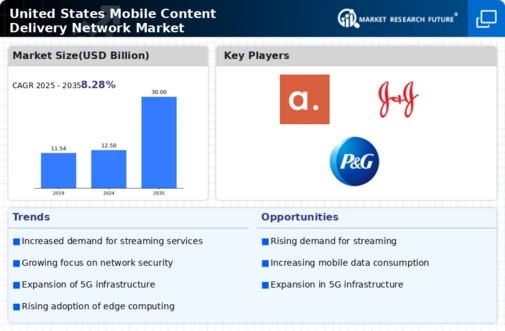Expansion of 5G Networks
The rollout of 5G networks across the US is significantly impacting the mobile content-delivery-network market. With 5G technology promising faster data speeds and lower latency, content providers are increasingly leveraging these advancements to enhance user experiences. The mobile content-delivery-network market is likely to benefit from the improved capabilities of 5G, which can support more simultaneous connections and higher data throughput. As of November 2025, it is estimated that 5G subscriptions in the US have surpassed 100 million, indicating a robust adoption rate. This expansion not only facilitates better streaming quality but also encourages the development of new applications that rely on high-speed data transfer, further propelling the mobile content-delivery-network market.
Rising Mobile Data Consumption
The mobile content-delivery-network market is experiencing a surge in demand due to the increasing consumption of mobile data. As users engage more with mobile applications, video streaming, and online gaming, the need for efficient content delivery becomes paramount. Recent statistics indicate that mobile data traffic in the US is projected to grow at a CAGR of 25% through 2025. This growth necessitates robust mobile content-delivery networks to ensure seamless user experiences. Consequently, service providers are investing heavily in infrastructure to accommodate this demand, thereby driving the mobile content-delivery-network market forward. The ability to deliver high-quality content with minimal latency is becoming a competitive advantage, prompting companies to enhance their offerings in this space.
Emergence of New Content Formats
The mobile content-delivery-network market is witnessing a transformation with the emergence of new content formats, such as augmented reality (AR) and virtual reality (VR). These formats require substantial bandwidth and low latency for effective delivery, which places additional demands on content delivery networks. As AR and VR applications gain traction in various sectors, including gaming, education, and retail, the mobile content-delivery-network market must adapt to accommodate these needs. The potential market for AR and VR is expected to reach $300 billion by 2025, indicating a lucrative opportunity for content delivery providers. This shift towards innovative content formats is likely to drive investments and technological advancements within the mobile content-delivery-network market.
Increased Focus on User Experience
In the competitive landscape of the mobile content-delivery-network market, companies are placing a heightened emphasis on user experience. As consumers become more discerning, the expectation for fast, reliable, and high-quality content delivery intensifies. Organizations are investing in advanced technologies such as AI and machine learning to optimize content delivery and personalize user interactions. This trend is reflected in the growing market for user experience solutions, which is projected to reach $20 billion by 2026. By prioritizing user experience, companies in the mobile content-delivery-network market can differentiate themselves and foster customer loyalty, ultimately driving growth in this sector.
Growing Importance of Data Security
As the mobile content-delivery-network market expands, the importance of data security becomes increasingly critical. With rising concerns over data breaches and privacy issues, content delivery providers are compelled to implement robust security measures. This includes encryption, secure access protocols, and compliance with regulations such as GDPR and CCPA. The market for cybersecurity solutions is projected to grow to $300 billion by 2026, reflecting the urgency for enhanced security in digital transactions. By prioritizing data security, companies in the mobile content-delivery-network market can build trust with consumers and ensure the integrity of their services, thereby fostering growth in this competitive landscape.

















Leave a Comment